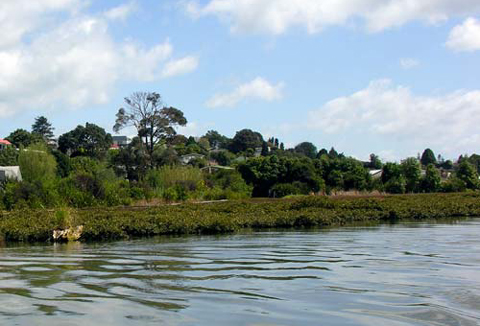Unwanted colonist?
Blogger: Forest & Bird’s North Island Field Officer, Al Fleming.
The seemingly innocuous, sea-dwelling plant that is the mangrove is dividing communities as it spreads throughout the estuaries and harbours in Northland and the Bay of Plenty.
A host of environmental factors has turned these coastal hotspots into prime mangrove habitat.
In the past 68 years, mangrove cover in Tauranga alone has increased by 2300% (40ha to 920ha) turning vast open-water vistas into forested expanses.
Debate has raged for years as to whether to keep these blue-green forests, or to chop them down.
The reasons for the flourishing mangrove population can be put down to several factors- catchment erosion and sedimentation, higher nutrient loads and fewer frosts (possibly global warming!) are all implicated.
The disappearance of uninterrupted blue vistas, vital bird roosts and access to these watery playgrounds has prompted local estuary care groups to wage war on mangroves*.
All mangroves cleared are taken off-site which has meant the humming sea-bed communities can still thrive, rather than become smothered by rotting forests.
Recently, the Bay of Plenty regional council has joined in the effort to remove mangroves and already they’ve earmarked 90 hectares of forest for removal.
So far 60 hectare have been mulched, however the National Institure of Water and Atmosphere (NIWA) has raised the alarm because of the affect on estuarine communities
These concerns prompted Forest and Bird members to inspect mangrove mulched areas at Omokoroa and Waikareao estuary. These site visits confirmed that these areas were in very poor health. Forest and Bird’s concerns are:
• sediment anoxic (the creation of oxygen depleted areas) associated with the presence of decomposing mulch.
• the resultant smothering of marine organisms.
• a lack of recovery within the mulched areas.
Other areas monitored by NIWA include Waikaraka, Te Puna and Matua estuaries. We visited the Matua estuary which appears to have recovered to some degree; possibly as the area mulched was narrower, smaller and had greater water flows.
In an attempt to find an acceptable solution, Forest & Bird has made it clear to the Bay of Plenty Regional Council that alternative methods of mangrove removal should be trialled and the effect of those trials monitored in a robust manner.
It is notable that the 3 other ‘northern’ regional councils, i.e. Waikato, Auckland and Northland, are all watching Bay of Plenty Regional Council response to NIWA’s and Forest and Bird’s concerns and recommendations. All of these councils are considering mangrove removal within their respective regions. This includes Whangamata, Kaipara and Mangawhai harbours
See http://www.youtube.com/watch?v=Eb1ZSqQx-g4 for a short video of the mulcher machine
See http://www.youtube.com/watch?v=Hxf8sGLaw6w for a short video of the groomer machine currently being trialled to remove mulch off site.
*On top of this, they have been involved in saltmarsh restoration, riparian planting and pest control work. Forest and Bird both congratulate and appreciate that this work is undertaken voluntarily with the health of the harbour and catchments in mind.

